Calculation of the dew point of the wall of a frame house. Formula calculation. Ways to eliminate condensation on the front doors
Dew point- this is the temperature of the environment at which the water in the air turns from a gas into a liquid (condenses).
Air humidity depends on its temperature. With the same amount of water vapor, cold air will be more humid than warm air.
If we smoothly cool the air, then a temperature will come at which the humidity will become one hundred percent. At this moment it falls liquid condensate(dew). This temperature is called the dew point.
The temperature and humidity of the air on the inner edge of the wall or roof of the house is much higher than on the street. This leads to the very smooth decrease in temperature inside the structure. With an illiterate selection of insulation, it is likely that inside the wall there will be such humidity and temperature at which condensation forms.
Dew point position in the design of the wall depends on:
- how warm it is inside the room;
- how cold it is outside;
- width and thermal conductivity building materials, of which the wall consists;
- indoor humidity;
- outdoor air humidity.
Let's find out how the position of the dew point changes in different situations.
 In a wall without insulation. If the wall of your house is not insulated at all, then the temperature inside its structure will gradually decrease from the inner edge to the outer.
In a wall without insulation. If the wall of your house is not insulated at all, then the temperature inside its structure will gradually decrease from the inner edge to the outer.
And then the dew point may be located: in the middle of the wall; close to the outer edge of the wall; close to the inner edge of the wall.
In a wall with insulation outside. In a place where a heater of sufficient thickness is located, a sharp temperature drop will be observed. Then the dew point will be inside the insulation, and the entire wall will be warm.
If the insulation has too little thickness, then the dew point may shift to the middle of the wall or to its inner edge.
In a wall with insulation inside. In this case, there will also be a sharp jump in temperature in the place where the heater is located. In this case, the wall will be in the cold zone and the dew point will shift to the inner edge of the wall.
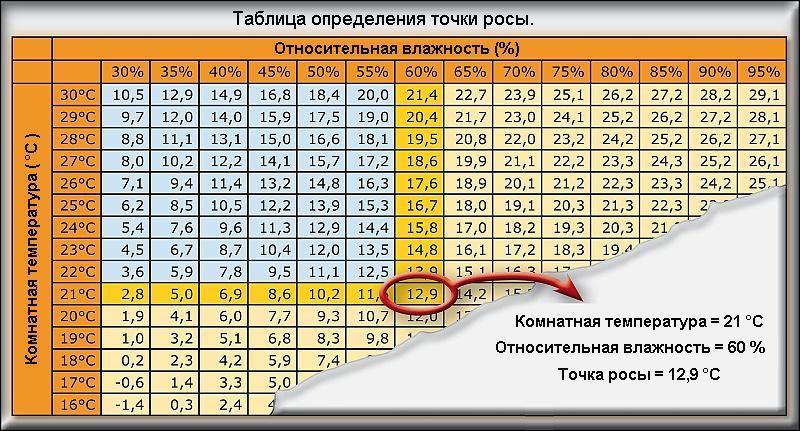 To find dew point temperature table must be used.
To find dew point temperature table must be used.
For this find in the table relevant room temperature and at the intersection with the current humidity readings will be the dew point temperature.
What are dew point methods the article "Determination of the dew point: secrets and nuances" will tell.
Consequences of illiterate choice and calculation
The dew point that occurs inside the material leads to its moisture. Walls getting wet has the following consequences:
- Moistened concrete and bricks have less heat-shielding properties.
- On a wet wall, fungus and mold can develop.
- In a room with wet walls there will be an unpleasant microclimate.
- If the moisture inside the wall freezes and crystallizes, then its crystals will destroy the material of the structure. Several cycles of freezing and thawing can lead to loss of strength of the material.
- For a heater, humidity is dangerous by the deterioration of its heat-shielding properties.
Advice! Wet insulation is easy to dry if you arrange special products. It is on this technology that a ventilated facade works.
The calculation of the insulation is reduced to the selection of its thickness in each specific case. In this calculation, it is necessary pay attention to the dew point position. An incorrect thickness of the layer of insulating material can lead to wetting and freezing of the entire wall structure.
To avoid getting wet load-bearing structure walls, it is best to place the insulation outside. In this case, it is necessary to provide for good ventilation of the insulation layer, as well as its protection from bad weather.
It is possible to place a heater indoors only at low humidity air or a small difference in temperature inside and outside your room.
Dew point - what is it and how to determine it in the wall, see the video:
About the dew point temperature, see the video tutorial:
During the design of thermal insulation of residential buildings, specialists always calculate the dew point in order to determine its position in the outer wall. This allows you to understand where there is a high probability of a significant amount of condensate, and thus find out how the selected material of the fence corresponds to the operating conditions.
We will not lay out here the calculation of the dew point using the formulas that are customary in construction, since it is rather complicated and cumbersome. By the way, many unscrupulous sellers of building materials use this, telling us about the release of moisture inside certain heaters. The purpose of this article is to help the average homeowner determine the dew point in the wall and use it in practice.
What is dew point
It must be understood that air always contains water vapor, the amount of which depends on many conditions. Inside the premises, steam is emitted from a person and from various daily processes of his life - washing, cleaning, cooking, and so on.
Outside, the moisture content in the air depends on the weather conditions, this is understandable. Moreover, the saturation of the air mixture with vapors has its own limit, upon reaching which condensation of moisture begins and fog appears.
It is generally accepted that at this moment the air has absorbed the maximum possible amount of steam and its relative humidity (indicated by the letter ω) is 100%. Further saturation just leads to the appearance of fog - small droplets of water in suspension. Nevertheless, everyone has seen condensation on various surfaces and without any fog.
This happens when air that is not fully saturated with vapors (humidity less than 100%) comes into contact with a surface whose temperature is several degrees lower than its own. The trick is that the air mixture at different temperatures can hold different amounts of steam. The higher the temperature, the more moisture it can absorb. Therefore, when a mixture with a relative humidity of 80% is in contact with a colder object, it cools rapidly, its saturation limit decreases, and the relative humidity reaches 100%.

At this moment, condensate begins to fall on the surface, the so-called dew point appears. It is this phenomenon that can be observed in the summer on the grass. In the morning, the ground and grass are still cold, and the sun quickly warms up the air, its humidity near the ground quickly reaches 100% and dew falls. It is noteworthy that the condensation process is accompanied by the release of thermal energy, which was previously spent on vaporization. That's why the dew quickly disappears.
It turns out that the dew point temperature is a variable value and depends on relative humidity and air temperature at a certain moment. In practice, these quantities are determined using various meters - thermometers and psychrometers. That is, after measuring the temperature and humidity of the air, we can assume at what surface temperature the dew point will appear according to the tables, which will be discussed later.
For reference. To determine the humidity of the outside air, it is not at all necessary to take any measurements now, just look at the weather forecast on the Internet. It also shows relative humidity.
Dew point determination
At the moment, it makes no sense to think about how to calculate the dew point, since this has long been done by specialists, and the results are summarized in a table. It indicates the surface temperatures below which condensation begins to form from air with different humidity.
![]()
As you can see, the normative temperature in the room is highlighted in purple here. winter time year - 20 °С, and the sector is marked in green, which covers the range of normalized humidity - from 50 to 60%. In this case, the dew point ranges from 9.3 to 12 °C. That is, subject to all standards, condensation of moisture inside the house is impossible, since there are no surfaces with such a temperature in it.

Another thing is the outer wall. Inside it is washed by air heated to +20 ° C, and outside - minus 20 ° C, or even more. This means that in the thickness of the wall the temperature gradually increases from minus 20 °С to + 20 °С, and in some place it will necessarily be equal to 12 °С, which at a humidity of 60% will give a dew point. But for this, you still need water vapor to get to this place through the material of the fence. And here another factor arises that affects the determination of the dew point - the vapor permeability of the material, which is always taken into account during construction.
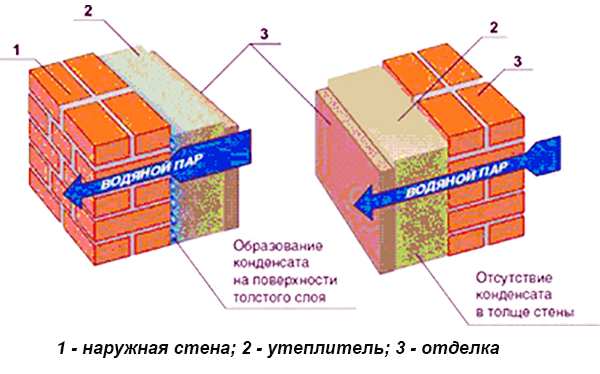
Now you can list all the factors that affect the formation of moisture inside the outer walls during operation:
- air temperature;
- relative humidity;
- temperature in the thickness of the wall;
- vapor permeability of the fencing material.
Note. There are no sensors or analyzers to measure these indicators in the thickness of the exploited walls; they can only be obtained by calculation.
Vapor permeability is a characteristic showing how much water vapor a particular material can pass through itself in a certain period of time. Permeable materials include all structural materials with open pores - concrete, brick, wood, and so on. There is an expression among the people that houses built from them “breathe”. Mineral wool and expanded clay are examples of porous insulation.
From the foregoing, we can conclude that in ordinary and insulated walls there are always conditions for the occurrence of a dew point. It is in this place that a lot of fables and horror stories appear, associated with a huge amount of water that directly flows out of the walls during condensation, and a mass of mold growing on them. In reality, everything is not so scary, because this point does not occupy a stationary position in the fence. Over time, the conditions on both sides of the structure are constantly changing, which is why the dew point in the wall moves. In construction, this is called the zone of possible condensation.
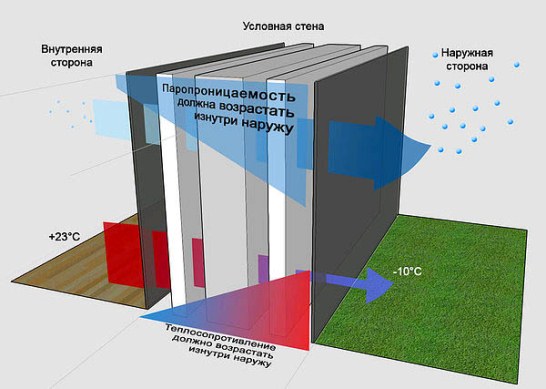
Since the fence is permeable, it is able to independently get rid of the released moisture, while ventilation on both sides plays an important role. It is not for nothing that the external wall insulation with mineral wool is made ventilated, because the dew point in this case is in the insulation. If everything is done correctly, then the moisture released inside the cotton wool leaves it through the pores and is carried away by the flow of ventilation air.
That's why it's so important to arrange good ventilation in residential premises, it removes not only harmful substances, but also excess moisture. The wall gets wet only in one case: when condensation occurs constantly and for a long time, and there is nowhere for moisture to go. Under normal conditions, the material simply does not have time to be saturated with water.
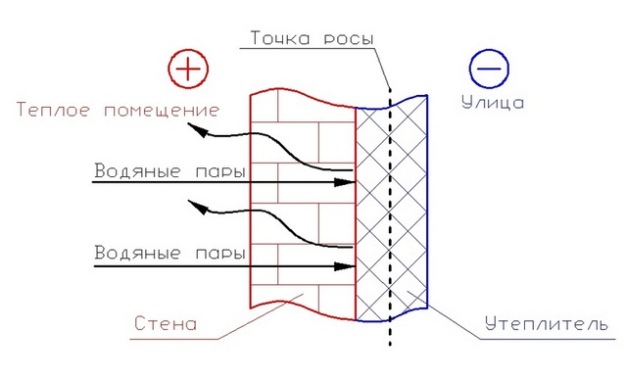
Modern polymer heaters practically do not let steam through, therefore, when insulating walls, it is better to place them outside. Then the temperature necessary for condensation will be inside the foam or polystyrene foam, but the vapors will not reach this place, and therefore there will be no moisture. And vice versa, it is not worth insulating with a polymer from the inside, since the dew point will remain in the wall, and moisture will begin to be released at the junction of the two materials.

An example of such condensation is a window with one glass in winter, it does not allow vapors to pass through, which is why water forms on the inner surface.
Internal insulation is feasible under the following conditions:
- the wall is quite dry and relatively warm;
- the insulation must be vapor-permeable so that the released moisture can leave the structure;
- The house must be well ventilated.
Conclusion
So, the dew point inside building structures is always present, while it is very difficult to calculate the amount of moisture formed using formulas, you can only determine the condensation zone. And this makes it possible to take measures to remove moisture, and sometimes completely prevent its appearance with the help of vapor-tight heaters.
Wall insulation is one of the main issues in construction. At first glance, it may seem that it is very easy to solve it - choose the one that suits the climatic conditions and finances, and insulate. However, it is not. There are a number of technical conditions that must be met so that the walls of the house do not get damp inside and do not freeze outside during the cold season.
One of these conditions is the insulation of the house so that the dew point is closer to the outer wall, and in no case - inside the house. To do this, you need to be able to determine where the dew point will be located under different conditions in order to exclude the possibility of condensation on the walls inside the room.
What is dew point
The dew point is the temperature at which the air is most saturated with steam and begins to condense. This indicator depends on two main factors: temperature and humidity.
When at least one of these two values \u200b\u200bchanges, the dew point also changes, that is, it constantly moves, just as the temperature and humidity of the air are not constant all the time.
There is a table of dew points at different temperatures and air humidity, developed by experts. From it you can see under what conditions the vapor begins to condense. For example, in winter, at a standard indoor air temperature of +200C and humidity from 50% to 60%, the dew point will range from 9.30C to 120C. That is, no condensation should form inside the room, since under the specified conditions there are no surfaces with such a temperature.
Let's consider further. If the house is +200C, and the temperature outside is -200C, then there is a dew point in the wall with a temperature of +120C at a relative humidity of 60%. The dew point can move along the thickness of the wall depending on the temperature inside and outside the room, as well as on the humidity in the wall itself. The closer the dew point is to the inside surface, the more likely the wall is to be wet from the inside. And this already creates unfavorable living conditions. By insulating the house, we can shift the dew point, as this changes the temperature of the wall itself.
Where will the dew point be?
There can be three options for wall construction: without insulation, with outer and inner lining. Consider where the dew point can be in each of these cases?
- Construction without insulation, then the dew point is located:
- inside the wall closer to the outer surface;
- inside the wall is shifted to the inner surface;
- on the inner surface - indoors, the wall will remain wet throughout the winter period.
2. There is an external insulation, then the dew point is:
- inside the insulation - this indicates that the calculation of the dew point and the thickness of the insulation are carried out correctly, and the wall in the room will be dry;
- any of the three cases described in paragraph 1 - the reason is the wrong choice of insulation and its characteristics.
3. Made the inner lining, the dew point will be:
- inside the wall closer to the insulation;
- on the inner surface of the wall under the sheathing;
- in the heater itself.
From the above, it becomes clear that the location of the dew point also depends on such characteristics of the fence as temperature and vapor permeability. Most modern heaters practically do not allow steam to pass through, therefore external wall cladding is recommended.
If you choose internal insulation, then the following conditions must be met in order to:
- the wall was dry and warm;
- the insulation had good vapor permeability and a small thickness;
- ventilation and heating functioned in the building.
Knowing the possible zones of condensate formation, i.e. the location of the dew point, it is possible for certain climatic zones to choose a type and material of insulation that will not create conditions for damp walls inside the house.
There is an opinion that the house should be insulated from the outside, and the insulation in all respects must comply with GOST. Then the dew point will be inside the skin, that is, outside the house, and internal walls will be dry in any season. That is why external insulation is more profitable than internal.
There are a lot of freebies on the web right now. online calculator and services that allow you to perform enough accurate calculations building structures.
In this review you will find a selection of calculation programs, using which you can quickly perform calculations on thermal insulation, fire protection, sound insulation, technical insulation, roofing, stone structures and sandwich panels.
Content:
5. Calculator for calculating stone structures
1. Calculators for calculating thermal insulation, sound insulation, fire protection
The calculation of the thickness of thermal insulation is one of the most important factors necessary in the design of building projects. One of the main parameters here is thermal resistance, which is calculated based on the climatic zone of a particular region, as well as the type of enclosing structures. It is also necessary to take into account other important details, a special program for calculating thermal insulation will help you do this.
1.1. Online thermal insulation calculator http://tutteplo.ru/138/ calculates the thickness of the insulation layer for buildings and structures in accordance with the requirements of SNIP 23-02-2003. Thermal protection of buildings. Employees of OJSC Institute "UralNIIAS" took part in the creation of a calculator for calculating the thickness of thermal insulation. As initial data, it is required to indicate the type of building (residential, public or industrial), the construction area, select the enclosing structures to be thermally insulated, and their characteristics. A wide range of popular brands is available as a heater, such as Rockwool, Paroc, Isover, Thermoplex and many others.
Based on the heat engineering calculation, the program determines the thickness of the insulation. If necessary, the site administration provides free online consultations for designers and specialists, and detailed calculation materials can be sent by e-mail upon request.
1.2. Thermal engineering calculator http://www.smartcalc.ru/
A detailed thermotechnical calculation of enclosing structures online can be performed in this program. To get started, the service asks you to enter data on the type of structures, the construction area and the temperature regime of the room. Further, the calculator processes the information and issues a decision on the compliance of the enclosing structures with the requirements of regulatory documentation.
The program features include the construction of thermal protection schemes, moisture accumulation and heat loss. For convenience, the menu has examples of ready-made solutions, after reading which, it will not be difficult to perform the calculation yourself.
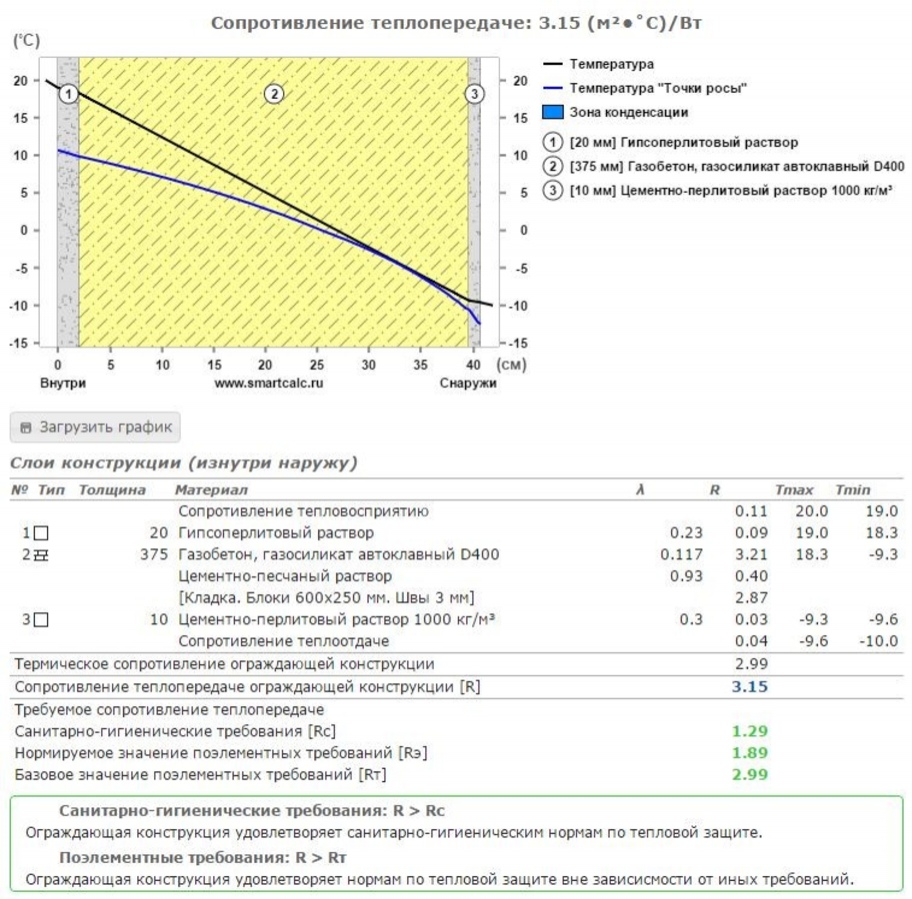
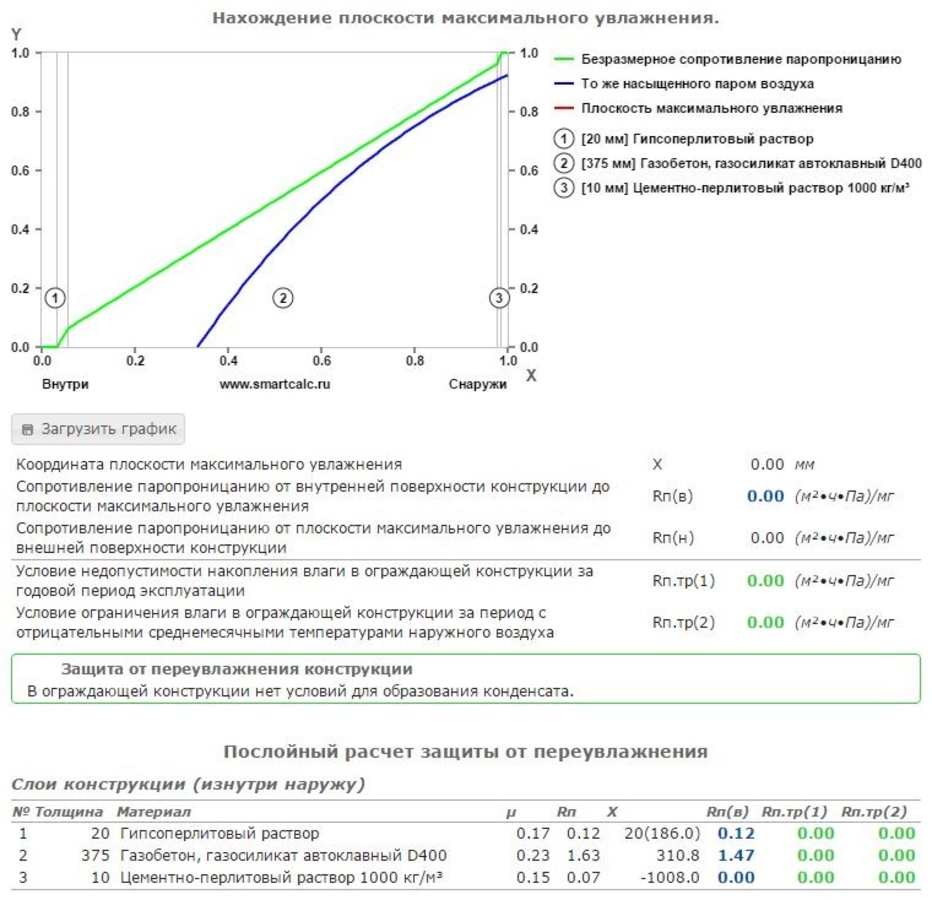
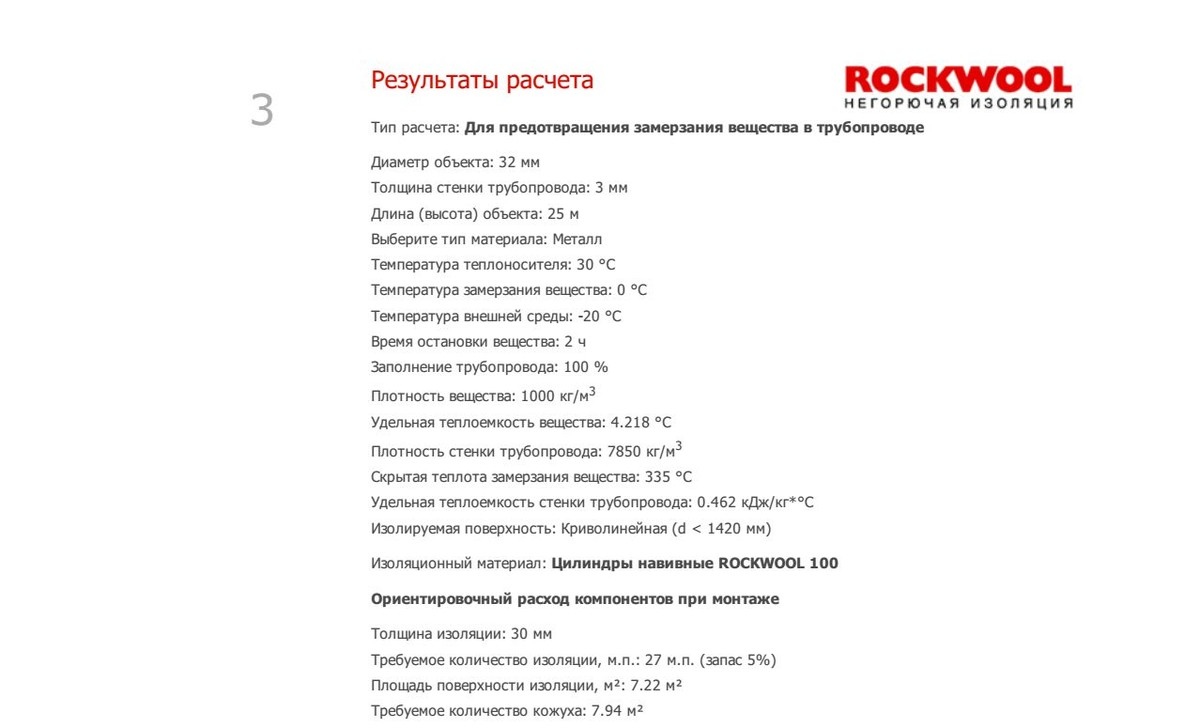
1.4 TechnoNIKOL calculators
By using online service TechnoNIKOL http://www.tn.ru/about/o_tehnonikol/servisy/programmy_rascheta/ can be calculated:
- thickness of sound insulation;
- consumption of materials for fire protection of metal structures;
- type and quantity of materials for flat roof;
- technical insulation of pipelines.
For example, consider a calculator that will allow you to perform flat roof calculation http://www.tn.ru/calc/flat/. At the beginning of the calculation, it is proposed to choose the type of TechnoNIKOL coating (Classic, Smart, Solo, etc.) C detailed description all types can be found on the same site in the appropriate section.
The next step is to enter the parameters of the roofing pie, the geographical location of the object and the geometric dimensions of the roof structures. Flat roof calculation results online program provided in Adobe Acrobat or Microsoft Excel format. The reporting document is drawn up on the letterhead of the company and contains two types of indicators: in enlarged and detailed forms. The resulting BOMs can be used directly to purchase the material.
TechnoNIKOL also offers to use soundproofing calculator http://www.tn.ru/calc/noise_insulation/ , in which two modes are available - for the developer and the designer. The sound insulation calculation program allows you to select a structure (wall, floor), type of room, noise source and other parameters. Further, the user can select one of several insulation systems suitable for his input.
Calculation of fire protection of metal structures can also be carried out using an internet program http://www.tn.ru/calc/fire_protection/ . It allows you to select the geometry of the structure (I-beam, channel, angle, rectangular or round pipe), its parameters according to GOST or dimensions for a welded structure, and then specify the method of heating and the degree of fire resistance. After that, the system will calculate the fire protection thickness and provide the results - the required thickness and volume of plates, as well as consumables.

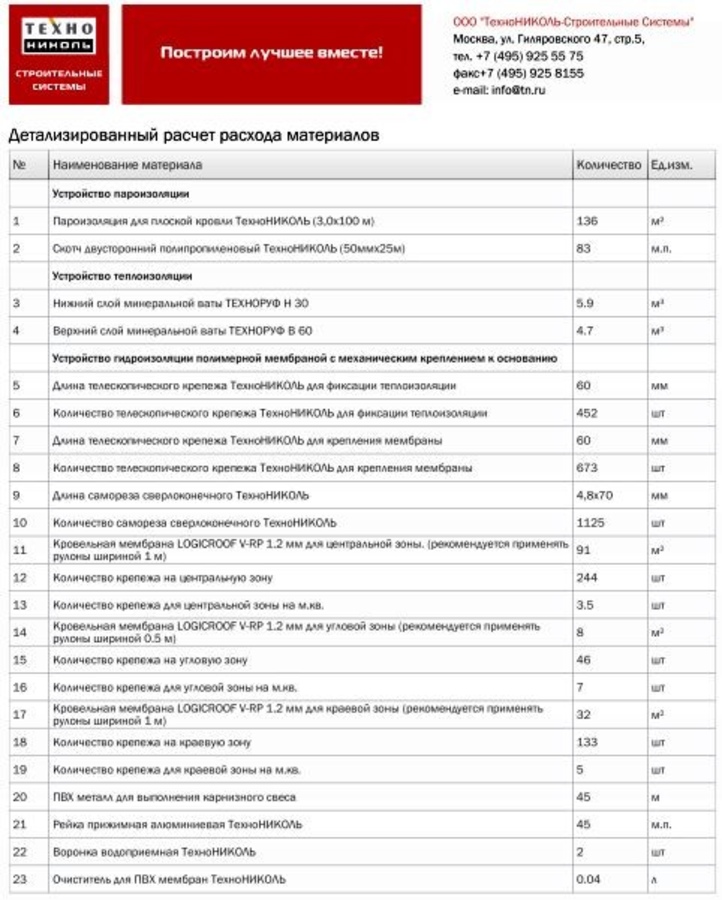
1.5 Thermal engineering calculatorParoc
The well-known Finnish manufacturer of thermal insulation materials Paroc on its Russian website offers to perform calculation of all types of heaters http://calculator.paroc.ru/ in accordance with the requirements of SP 50.13330.2015 "Thermal protection of buildings".
To do this, it is necessary to indicate the design of the wall, covering or floor of the building, clarify the temperature regimes and the geography of the location of the object. As a result, the program will calculate the resistance of building structures to heat transfer and determine the minimum allowable thickness of the insulation. The progress report can be printed or saved as a PDF file.
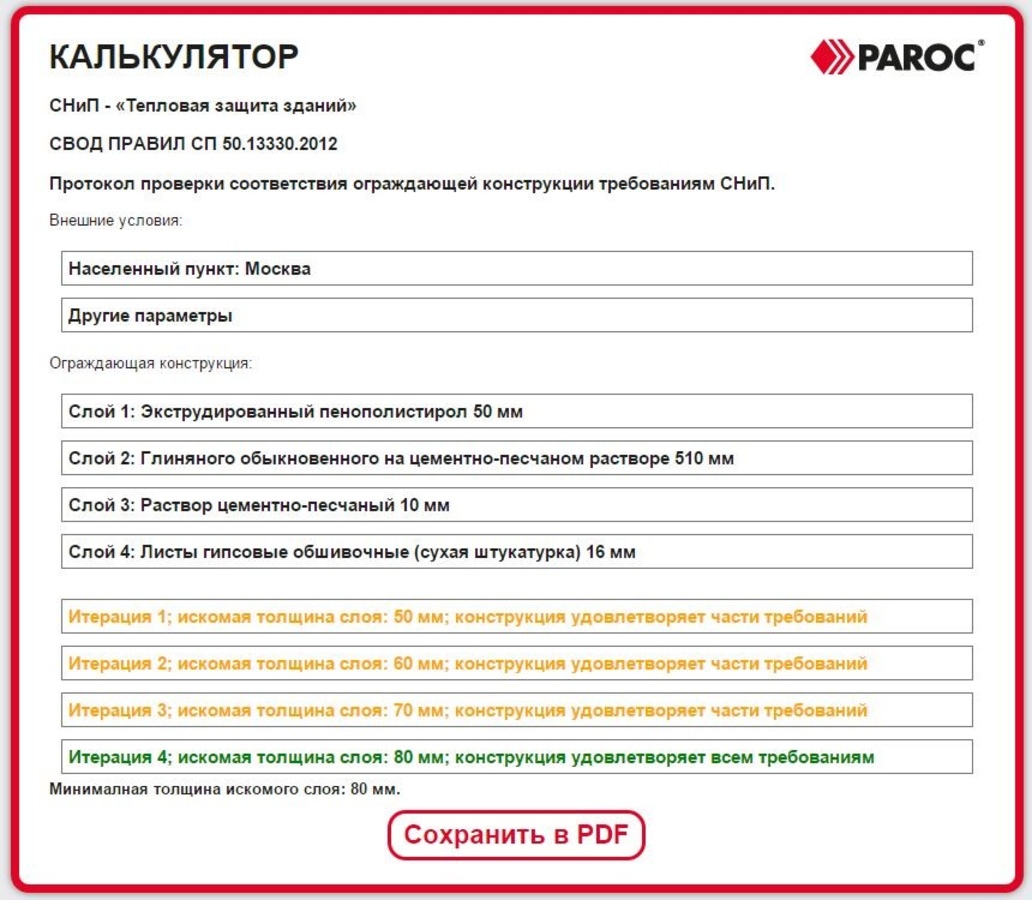
1.6. thermal insulation Baswool
The domestic company Agidel LLC, which produces popular thermal insulation materials Baswool, offers for its products free calculator http://www.baswool.ru/calc.html . The interface of the resource is very simple, and the calculation is proposed to be performed in several steps, step by step indicating the city of construction, the category of the building, and the structure to be insulated. As a result, the program will provide a choice of several options for Baswool insulation systems indicating the thickness of the material.

1.7. Settlement programs
One of the leaders of domestic manufacturers of finishing materials TM "Osnovit" offers on its website to calculate the scope of work and the cost of their implementation for free. By using Calculator Founds http://osnovit.ru/system-calc/calc.php you can determine the parameters of facade thermal insulation. By entering a standard set of initial data, the user receives the final specification of the proposed set of materials for the installation of a warm facade.

Additionally, the Osnovit service allows determine the consumption of any material from your production line . The advantage of this calculation is that the results are given with reference to the packaging units of the goods. For example, by selecting the Startline FC41 H screed from the product category menu “Floor mixes”, specifying the thickness of its application and total area surface, the user will know how many bags of dry mix he will need.

2. Calculation of technical insulation
2.1. Calculator for calculating technical insulation fromIsotec
Isotec is a trademark of the well-known international company "Saint Gobain", under which a line of technical insulation is produced. These materials are used for fire-fighting treatment of building structures, thermal insulation of heating and air conditioning pipelines, as well as industrial capacitive structures.
The company's website offers to calculate the thermal characteristics of the system using free online program http://calculator.isotecti.ru/ . The calculator works in accordance with the regulation SP 61.13330.2012 (thermal insulation for equipment and pipelines). The calculation is performed based on the specified criteria: the surface temperature of the pipeline, the transported flow, the difference in temperature characteristics along the length, and so on. The required conditions are set by the user in the site menu.
After that, it is necessary to choose one of the proposed options for the Isotec thermal insulation device (for example, cylinders for pipelines). The program will automatically determine the thickness of the material.
2. 2. In the same way, it is possible to calculate the thermal insulation of pipelines using already the familiar Paroc service http://calculator.paroc.ru/new/ . All calculations are performed in accordance with SP 61.13330.2012 Thermal insulation of equipment and pipelines (updated version of SNiP 41-03-2003). With it, you can choose the optimal characteristics and type of technical insulation. The system includes various calculation methods - according to the heat flux density, its temperature, to prevent liquid freezing, etc. To calculate the thickness of the thermal insulation of pipelines, you need to select a method, enter the necessary data (diameter, material, thickness of the pipeline, etc. .), after which the program will immediately give the finished result. At the same time, various important factors- temperature of the contents of the pipeline, environment, the magnitude of the mechanical load on the pipeline and others. As a result, the calculator for calculating the thermal insulation of pipelines will determine the thickness and volume of the insulation.
3. Calculation of the roof
Calculation of roofing materials online can be performed on specialized resource of metal tiles http://www.metalloprof.ru/calc/ . To do this, you need to choose the shape of the roof, indicate its main dimensions and determine the type of roofing material. The program will give out the consumption of metal tiles, the number of skates, cornices and fasteners. As a result, the cost of the material will be calculated in accordance with the current price list of the supplier.
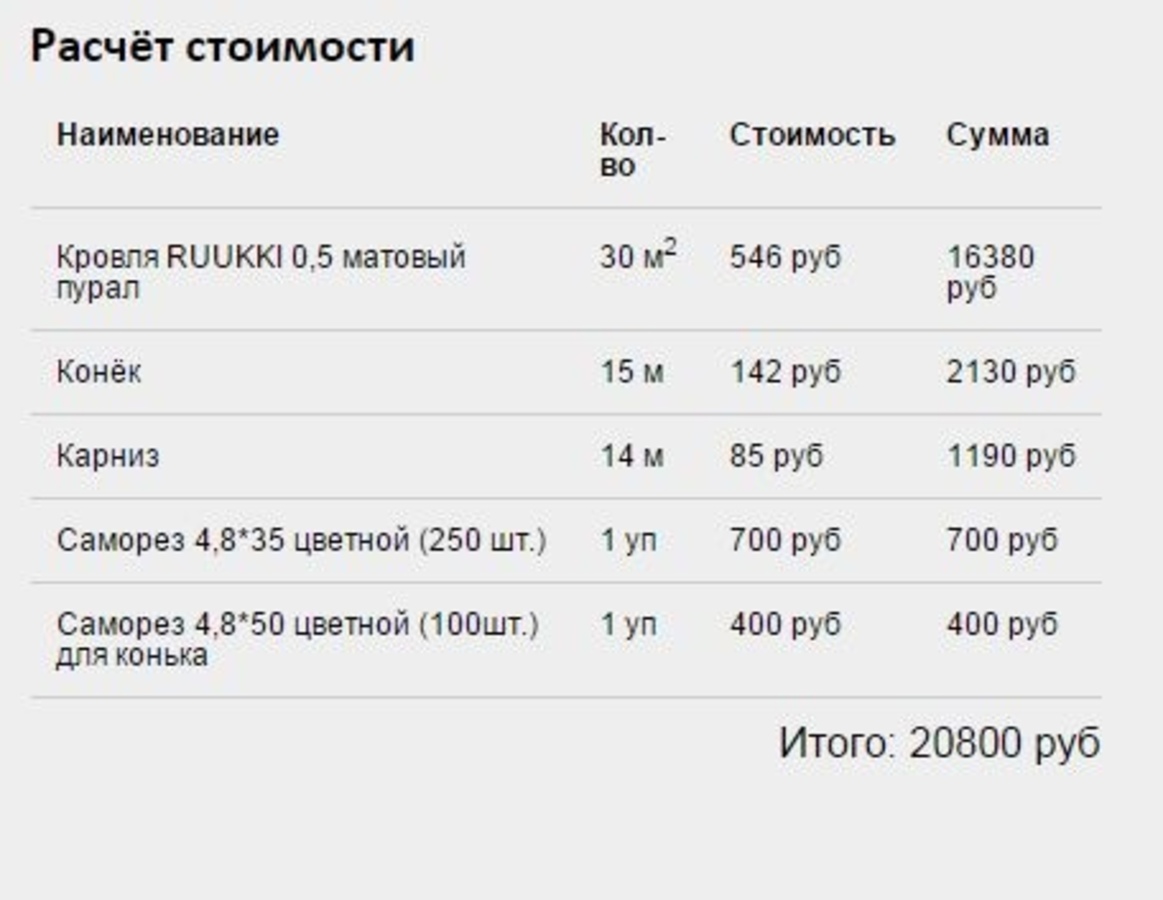
4. Sandwich panel calculator
If you need to calculate the sandwich panels required for the construction of a particular building, then you can also do this online using free calculators. The Teplant service, which offers the user the function online calculator for an approximate calculation of the size of sandwich panels http://teplant.ru/calculate/ and other parameters (number of panels and other elements, consumables). This is a universal service with which you can easily calculate how wall sandwich panels, and roof sandwich panels. For the calculation, it is necessary to indicate the type of roof of the building, its dimensions, select the color of the panels and their type (wall, roof).
The program will determine the amount of material, fasteners and fittings, as well as calculate their cost.
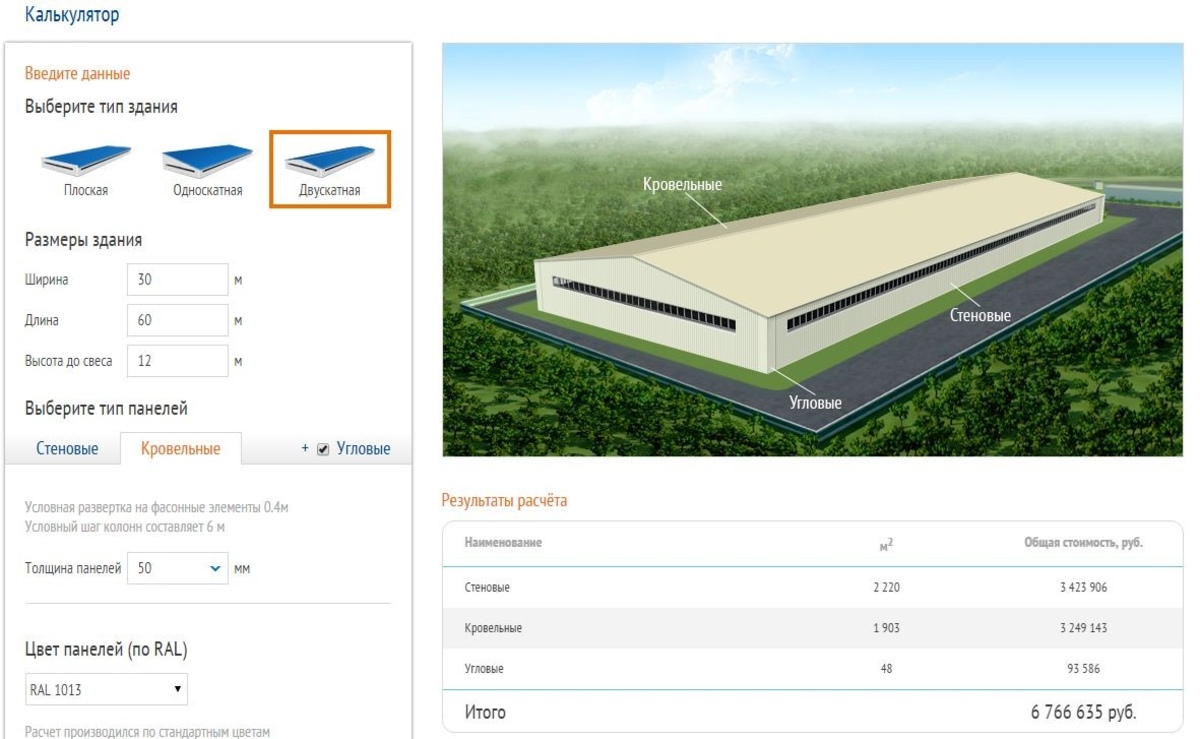
5. Calculator for calculating stone structures
5.1. Calculation of aerated concrete
As for such a popular area as calculating aerated concrete online, you will find many suitable services on the Internet for this operation. For example, this aerated concrete online calculator http://stroy-calc.ru/raschet-gazoblokov , with which you can easily calculate the number of aerated concrete or gas silicate blocks required for the construction of the facility. At the same time, all the necessary parameters are taken into account - length, width, density, height, etc., allowing you to quickly calculate the calculation of aerated concrete for a house. A similar service can be found on many other sites of building materials manufacturers. For example, aerated concrete calculator from Bonolit http://www.bonolit.ru/raschet-gazobetona/ will give you a whole list of results - the number of blocks in units and m3 and even the number of bags of glue.
Bonolit, a company specializing in the production of autoclaved aerated concrete (aerated concrete), for the convenience of customers, provides a free service to determine the scope of work when laying the walls of a house. The calculation program is available at : http://www.bonolit.ru/raschet-gazobetona/
As initial data, the calculator asks for the dimensions of the house, the length of the internal load-bearing walls, the number of storeys, the type of floors, the size and number of openings. The result of the calculation is provided in the form of a specification of materials and their estimated cost. At the same time, it is possible to immediately send an order for the purchase of aerated concrete.
5.2. Calculation for brick walls
Stroy Calc online service http://stroy-calc.ru/raschet-kirpicha/ carries out the calculation of building materials for laying the walls of the house. Parameters can be defined for walls made of bricks, building blocks, timber and logs. For example, when erecting a brick building, it is necessary to set the perimeter, height and thickness of walls, the number and size of openings, as well as the cost per unit of material as initial data. The program will determine the consumption of bricks in pieces and cubes, its cost, as well as the required volume of mortar. This will indicate the weight of the walls for calculating the foundation. The service also allows you to choose the type and amount of insulation. To do this, when defining the parameters of the walls, you must check the appropriate box.


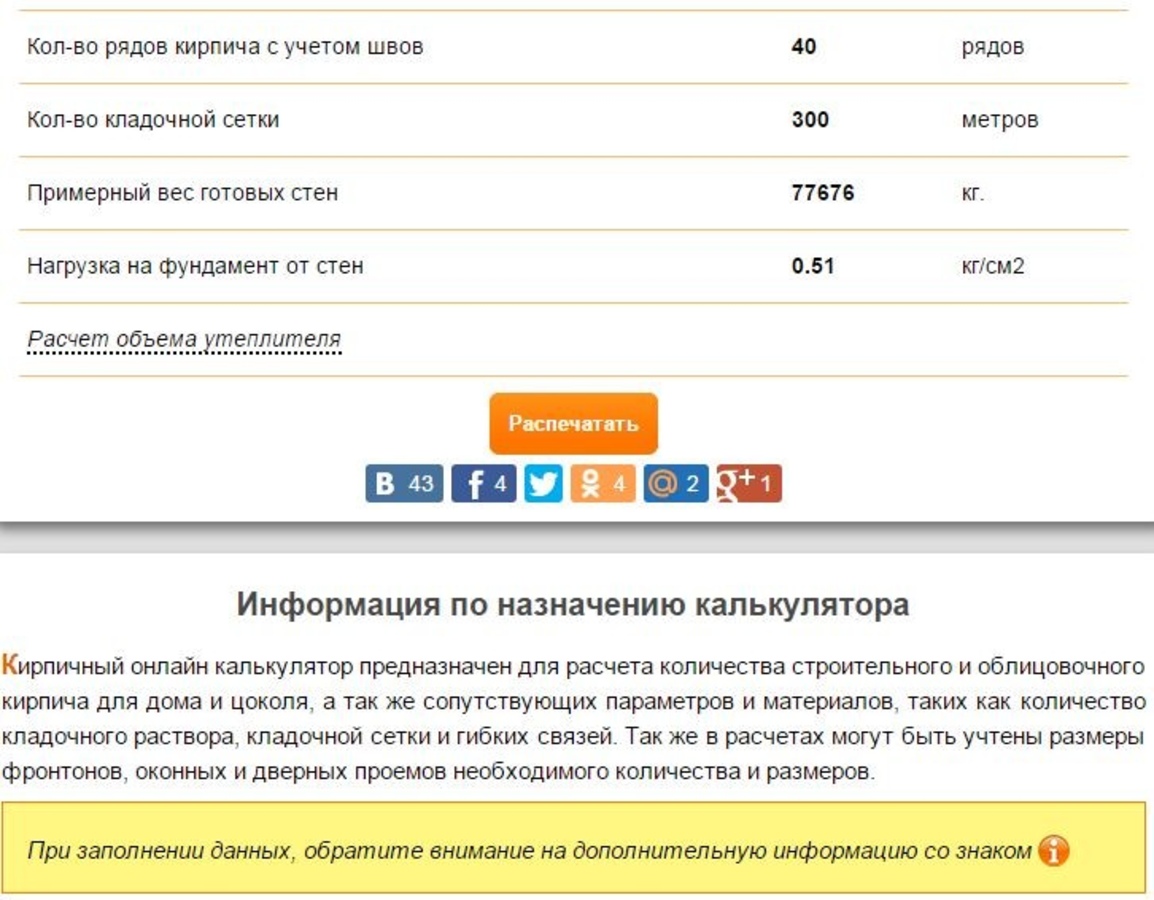
5.3 Wienerberger warm block calculator
The world famous brand Wienerberger, leader in the production of warm ceramics, offers on its website determine the consumption of Porotherm building blocks http://www.wienerberger.ru/toolkit/calculation-of-consumption-blocks . For the calculation, you must enter the dimensions of the walls of the house, indicate the dimensions of the openings, their number.
The program will pick up possible options masonry and will issue the costs of blocks of various parameters. The result of such a calculation will be indicative, but these data will be quite enough to draw up a preliminary construction estimate. To clarify the scope of work, the resource suggests contacting a company specialist.
So, in this article, we examined the most convenient and popular online services designed for calculating building materials. It is worth noting that each of them is free and also has a convenient modern interface. All these resources are developed in the form of detailed calculators placed directly on the site pages. Thus, you can easily and quickly make the calculations you need.
Carrying out thermal insulation work in a private house or apartment, you come across such a concept as the dew point. What is it and why is it so important? Let's start with an analysis of the concept itself, and we will answer the question, what is a dew point?
So, the dew point is a kind of indicator at which the moisture content (wet vapor) in the air around us is determined. That is, it turns out that the greater the humidity, the higher the dew point. But at the same time, two criteria must be taken into account - these are unchanged indicators of pressure and temperature of the ambient air
Important. Not everyone knows that the dew point is measured in degrees. It turns out that this is a certain air temperature at which he himself is saturated with moist vapors. But it is necessary to take into account the fact that the point cannot be higher than the temperature of that same air.
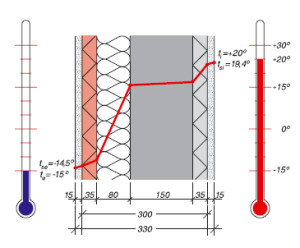
Recall the process of condensation, where warm air, in contact with a cold surface, forms water droplets. So the temperature of this very surface is the dew point. To understand how this indicator works in reality, it is necessary to consider how fog is formed. In this case, the two temperature readings must match, namely the dew point temperature and the ambient air temperature. That is, given this, you can accurately say what humidity is present in the room or on the street.
How to calculate dew point
The question of how to calculate the dew point is one of those that should worry people who decide to insulate their home. The thing is that the choice of the process of thermal insulation from the outside or from the inside just concerns this indicator.
The dew point calculation can be done in different ways:
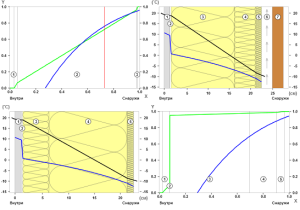
How to determine the dew point
We return to the topic of thermal insulation. The concept and definition of the dew point in construction is an important criterion for a properly conducted thermal insulation process. Competent calculation is the absence of further condensation on the walls and other structures of the building. And this not only affects the quality of living, but also the life of the entire building.
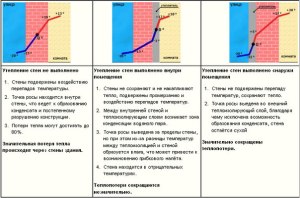
Dew point location
Every wall has its own humidity. And if you correctly and correctly calculate the dew point, then you can accurately find the place where this indicator will act. For example, the following situation: the temperature inside the room + 20C - + 25C, humidity from 60%. If the temperature of the wall is +12°C or lower, then the appearance of condensate on this wall cannot be avoided. By reducing the humidity to, say, 30-40%, you can ensure that no moisture builds up on the wall. Condensation will form if the wall temperature falls below +6°C. Here is such a relationship.
We can conclude: the dew point in the wall, or rather, its location, will depend on five indicators:
- external and internal;
- external and internal humidity;
- the thickness of the structure, in this case the wall and the insulation used.
Comparing two walls, insulated and not insulated, according to GOST or SNiP, interesting parallels can be drawn that will help you choose the right thickness of the insulation material.
For an uninsulated wall, there are three options:
- the dew point falls within the gap between the outer surface and the center of the wall. In this case, the inner surface will be dry in any way;
- between center and inner surface. In this case, the wall from inside the room will get wet when the temperature drops outside;
- on the inner surface. There are no options here - it will always get wet.
Insulated walls can be thermally insulated from the outside or from the inside. Both options must be considered. Let's start with insulation from the outside:
- if the calculation was carried out correctly exactly according to GOST or SNiP, and accordingly the thickness of the insulation was determined exactly according to GOST (SNiP), then the dew point remains on the insulation itself, the wall will always be dry;
- this criterion falls into any other place - this is a wrong calculation, the wall will be wet, and in this case it makes no difference which insulation you have chosen.
Important. Insulation from the inside according to GOST or SNiP is a more complex system, because it will be difficult to find the location of the dew point. In this case, the place itself is shifted towards the room, that is, the temperature under the heat insulator will always be lower.
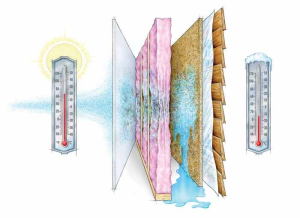
The best option is if the point falls between the center of the wall and heat-insulating material. It is bad if the point is shifted by inner surface walls. It is very bad if it is installed on a heater.
Comparing all situations, we can conclude that best option insulation according to GOST or SNiP, if carried out outside. But unfortunately, this is not always possible. Therefore, thermal insulation work carried out from the inside should be supported by one very important criterion - reducing humidity inside the house.
How can I do that? Just install efficient ventilation, plus heating that maintains a certain temperature. Let's not forget about the thickness of the insulation, which can be calculated manually using formulas, tables and a calculator.
So, let's sum up. The dew point is the temperature at which humidity begins to form when two temperatures (internal and external) come into contact. In fact, this is a kind of temperature boundary where cold and heat meet. The dependence of this indicator is shown above both in the article itself and in the attached pictures. This will be easy to deal with. The main thing is to understand what the dew point depends on, what factors act in place of its displacement. The last criterion is very important in the process of choosing the type and size of the thickness of the insulation. Do not forget about the thickness of the walls, the location of the point also depends on this indicator.
Like?
See related articles:




